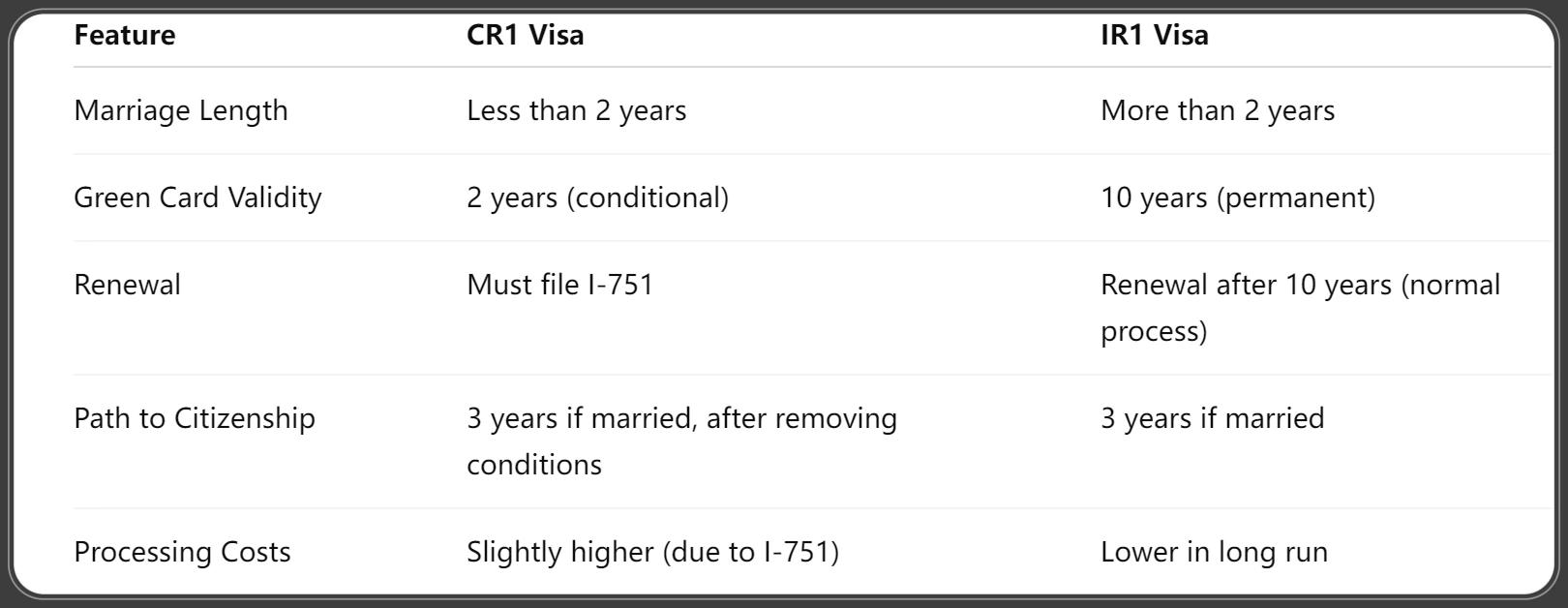CR1 vs IR1 2025: Key Differences, Processing Times, and Benefits Explained
Published on August 21, 2025

Sarah Martinez, J.D.
Immigration Attorney
Sarah Martinez, J.D., is an immigration attorney helping families navigate petitions, adjustments of status, and consular processes, with over a decade of hands-on legal experience.
CR1 vs IR1 2025: Key Differences, Processing, and Benefits Explained
Introduction to CR1 and IR1 Visas
For couples navigating the U.S. immigration system in 2025, two of the most common visa options are the CR1 (Conditional Resident) visa and the IR1 (Immediate Relative) visa. Both are designed for foreign spouses of U.S. citizens, but the visa you receive depends on how long you’ve been married at the time of approval.
This guide will break down the differences between CR1 and IR1 visas in 2025, covering eligibility, benefits, processing times, and strategies to ensure a smooth application process.
What Are Marriage-Based Green Cards?
A marriage-based green card allows the spouse of a U.S. citizen to live and work permanently in the United States. Unlike fiancé visas (K-1), marriage-based visas (CR1 and IR1) grant permanent residency immediately upon entry.
Why CR1 and IR1 Are Important in 2025
With longer processing times and stricter scrutiny on marriage-based applications in recent years, understanding the differences between CR1 and IR1 visas is crucial for couples planning their future together.
Understanding the CR1 Visa (Conditional Resident)
Eligibility Requirements
The CR1 visa is issued when the marriage is less than two years old at the time of green card approval.
Conditional Green Card Validity
- Valid for 2 years only.
- Applicants must later file Form I-751 (Petition to Remove Conditions) within 90 days before expiration.
When to File for Removal of Conditions (Form I-751)
Failure to remove conditions results in loss of permanent resident status, which may lead to deportation.
Understanding the IR1 Visa (Immediate Relative)
Eligibility Requirements
The IR1 visa is issued when the marriage is more than two years old at the time of green card approval.
Permanent Green Card Benefits
- Valid for 10 years.
- No need to file Form I-751.
Long-Term Residency and Citizenship Path
After holding IR1 status, a spouse can apply for U.S. citizenship in as little as 3 years (if still married to the U.S. citizen).
CR1 vs IR1: Key Differences in 2025

Application Process for CR1 and IR1 in 2025
Applying for either a CR1 or IR1 visa involves the same general steps. The only difference is whether your marriage length qualifies you for the conditional (CR1) or permanent (IR1) green card.
Step 1: Filing the I-130 Petition
The U.S. citizen spouse begins the process by filing Form I-130 (Petition for Alien Relative) with USCIS. This establishes the legal relationship between spouses.
- Required documents:
- Marriage certificate
- Proof of U.S. citizenship (passport or birth certificate)
- Evidence of bona fide marriage (photos, joint accounts, leases)
Step 2: National Visa Center (NVC) Processing
Once USCIS approves the I-130, the petition moves to the National Visa Center (NVC). At this stage, applicants submit:
- DS-260 (Immigrant Visa Application)
- Affidavit of Support (Form I-864)
- Civil documents (birth certificate, police records, etc.)
Step 3: Interview at the U.S. Embassy or Consulate
The foreign spouse attends an interview at the U.S. consulate in their country. The consular officer will:
- Verify the authenticity of the marriage.
- Review documents.
- Ask personal questions about the couple’s relationship.
Step 4: Entering the U.S. as a Permanent Resident
Upon visa approval, the foreign spouse enters the U.S. and automatically becomes a lawful permanent resident.
- If married less than 2 years → CR1 visa issued.
- If married more than 2 years → IR1 visa issued.
Processing Times and Backlogs in 2025
Expected Timelines for CR1
- USCIS I-130 approval: 9–12 months
- NVC processing: 3–6 months
- Consular interview: 2–3 months
- Total time: ~14–21 months
Expected Timelines for IR1
Processing timelines are identical to CR1. The difference only arises in the type of green card issued at the end.
Delays and Common Issues
- Requests for Evidence (RFE) if documents are incomplete.
- Extended administrative processing if the consular officer has doubts about marriage authenticity.
- Country-specific backlogs due to high demand.
CR1 and IR1 Visa Costs in 2025
Government Filing Fees
- I-130 Petition: $535
- DS-260 and NVC fees: $445
- Green Card Fee (after entry): $220
Medical Exam and Additional Costs
- Medical examination: $200–$500 (varies by country).
- Vaccinations, translations, and document courier fees.
Attorney Fees and Other Expenses
Hiring an immigration attorney can cost between $2,000–$6,000, depending on case complexity.
💡 Over time, the IR1 is less expensive, as CR1 applicants must also pay for the I-751 removal of conditions later.
Benefits of CR1 and IR1 Visas in 2025
Work Authorization
Unlike fiancé visas (K-1), CR1 and IR1 visa holders can work immediately upon entering the U.S. No separate work permit (EAD) is required.
Travel Flexibility
Both visas allow unlimited travel outside the U.S. as long as permanent residency is maintained.
Pathway to Citizenship
Spouses of U.S. citizens may apply for naturalization after 3 years of permanent residency, provided they remain married and living with the U.S. citizen spouse.
Common Challenges Applicants Face
Proving a Bona Fide Marriage
One of the biggest hurdles is convincing USCIS and consular officers that the marriage is genuine. Applicants must provide strong evidence like:
- Joint financial accounts
- Lease/mortgage agreements
- Photos from different life events
- Communication records
Administrative Processing and Delays
Some cases undergo additional security checks, delaying visa issuance for months.
Risk of Denial
Petitions may be denied if:
- The marriage appears fraudulent.
- Financial requirements for the Affidavit of Support aren’t met.
- Missing documents cause suspicion.
Tips for a Successful CR1/IR1 Visa Application
Gather Strong Evidence of Marriage
Provide a wide range of documents to prove your relationship is real. The more evidence, the better.
Prepare for the Consular Interview
Expect personal questions such as:
- “How did you meet?”
- “What was your wedding like?”
- “What are your spouse’s hobbies?”
Work with Experienced Immigration Attorneys
Professional legal guidance can:
- Prevent mistakes on forms.
- Strengthen your petition.
- Handle complex cases (previous marriages, immigration violations, etc.).
CR1 vs IR1 in 2025: Which Is Better for You?
When CR1 Is the Only Option
If you’ve been married for less than 2 years, CR1 is unavoidable. It grants conditional residency but requires filing to remove conditions later.
When IR1 Is More Beneficial
If you’ve been married for more than 2 years, IR1 is clearly the better option. It offers a 10-year green card with fewer renewal hassles.
Strategic Planning for Couples
Some couples may delay filing until after their 2-year marriage anniversary to qualify for IR1 instead of CR1. However, this depends on personal and legal circumstances.
Frequently Asked Questions (FAQs)
1. What is the difference between CR1 and IR1 in 2025?
- CR1 is for marriages under 2 years → 2-year conditional green card.
- IR1 is for marriages over 2 years → 10-year permanent green card.
2. Do both CR1 and IR1 lead to citizenship?
Yes. Both visas provide a pathway to U.S. citizenship after 3 years (if married to a U.S. citizen).
3. Can I work immediately after entering the U.S. with CR1 or IR1?
Yes. Both visas grant immediate work authorization.
4. How long does it take to switch from CR1 to IR1?
You don’t “switch.” Instead, you file Form I-751 to remove conditions after 2 years. Once approved, you receive a 10-year green card.
5. What happens if I divorce before conditions are removed?
You can still file a waiver of joint filing requirement if you prove the marriage was genuine but ended in divorce.
6. Is there a lottery or cap for CR1 and IR1 visas?
No. Unlike H-1B visas, there is no cap or lottery for marriage-based visas.
Conclusion: CR1 vs IR1 in 2025 – Choosing the Right Path
Both CR1 and IR1 visas offer foreign spouses a chance to live, work, and build a future in the U.S. in 2025. The main difference lies in marriage duration and whether the green card issued is conditional or permanent.
- CR1 → for marriages under 2 years, requires condition removal later.
- IR1 → for marriages over 2 years, grants a full 10-year green card immediately.
For couples planning their future together, strategic timing and careful documentation can make the process smoother. Whether you qualify for CR1 or IR1, both visas provide a secure path toward permanent residency and U.S. citizenship.
You Might Also Like
NTA After I-130 Denial 2025: Essential Guide for Families and Immigrants
Aug 26, 2025Consular Processing vs Adjustment 2025: Which is Faster, Cheaper, and Best for You?
Aug 26, 2025Waiver I-601 Family 2025: Processing Times, Extreme Hardship & Approval Tips
Aug 26, 2025Online Filing I-130 2025: Step-by-Step Guide, Processing Times, and Costs
Aug 21, 2025I-751 Timeline 2025: How Long It Takes to Remove Conditions on Your Green Card
Aug 14, 2025
